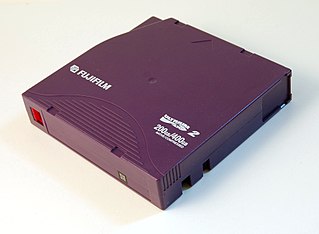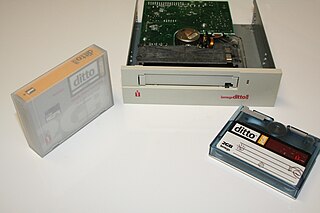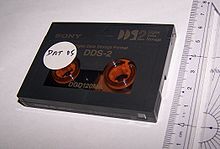The megabyte is a multiple of the unit byte for digital information. Its recommended unit symbol is MB. The unit prefix mega is a multiplier of 1000000 (106) in the International System of Units (SI). Therefore, one megabyte is one million bytes of information. This definition has been incorporated into the International System of Quantities.

A tape drive is a data storage device that reads and writes data on a magnetic tape. Magnetic tape data storage is typically used for offline, archival data storage. Tape media generally has a favorable unit cost and a long archival stability.
ZIP is an archive file format that supports lossless data compression. A ZIP file may contain one or more files or directories that may have been compressed. The ZIP file format permits a number of compression algorithms, though DEFLATE is the most common. This format was originally created in 1989 and was first implemented in PKWARE, Inc.'s PKZIP utility, as a replacement for the previous ARC compression format by Thom Henderson. The ZIP format was then quickly supported by many software utilities other than PKZIP. Microsoft has included built-in ZIP support in versions of Microsoft Windows since 1998 via the "Windows Plus!" addon for Windows 98. Native support was added as of the year 2000 in Windows ME. Apple has included built-in ZIP support in Mac OS X 10.3 and later. Most free operating systems have built in support for ZIP in similar manners to Windows and Mac OS X.

Digital Linear Tape is a magnetic-tape data storage technology developed by Digital Equipment Corporation (DEC) from 1984 onwards. In 1994, the technology was purchased by Quantum Corporation, who manufactured drives and licensed the technology and trademark. A variant with higher capacity is called Super DLT (SDLT). The lower cost "value line" was initially manufactured by Benchmark Storage Innovations under license from Quantum. Quantum acquired Benchmark in 2002.

Advanced Intelligent Tape (AIT) is a discontinued high-speed, high-capacity magnetic tape data storage format developed and controlled by Sony. It competed mainly against the DLT, LTO, DAT/DDS, and VXA formats. AIT uses a cassette similar to Video8. Super AIT (SAIT) is a higher capacity variant using wider tape in a larger, single-spool cartridge. Both AIT and SAIT use the helical scan method of reading and writing the tape.

Linear Tape-Open (LTO) is a magnetic tape data storage technology originally developed in the late 1990s as an open standards alternative to the proprietary magnetic tape formats that were available at the time. Hewlett Packard Enterprise, IBM, and Quantum control the LTO Consortium, which directs development and manages licensing and certification of media and mechanism manufacturers.

Travan is an 8 mm magnetic tape cartridge design developed by the 3M company, used for the storage of data in computer backups and mass storage. Over time, subsequent versions of Travan cartridges and drives have been developed that provide greater data capacity, while retaining the standard 8 mm width and 750' length. Travan is standardized under the QIC body. HP Colorado, Iomega DittoMax and AIWA Bolt are proprietary versions of the Travan format.

The 8 mm backup format is a magnetic tape data storage format used in computer systems, pioneered by Exabyte Corporation. It is also known as Data8, often abbreviated to D8 and is written as D-Eight on some Sony branded media. Such systems can back up up to 60 GB of data depending on configuration. The cassettes have the same dimensions and construction as the cassettes used in 8 mm video format recorders and camcorders.

The Ditto drive series was a proprietary magnetic tape data storage system released by Iomega during the 1990s. It was marketed as a backup device for personal computers.
The 3480 tape format is a magnetic tape data storage format developed by IBM. The tape is one-half inch (13 mm) wide and is packaged in a 4 in × 5 in × 1 in cartridge. The cartridge contains a single reel; the takeup reel is inside the tape drive.

DVD recordable and DVD rewritable are optical disc recording technologies. Both terms describe DVD optical discs that can be written to by a DVD recorder, whereas only 'rewritable' discs are able to erase and rewrite data. Data is written ('burned') to the disc by a laser, rather than the data being 'pressed' onto the disc during manufacture, like a DVD-ROM. Pressing is used in mass production, primarily for the distribution of home video.
Office Open XML is a zipped, XML-based file format developed by Microsoft for representing spreadsheets, charts, presentations and word processing documents. Ecma International standardized the initial version as ECMA-376. ISO and IEC standardized later versions as ISO/IEC 29500.

VXA is a tape backup format originally created by Ecrix and now owned by Tandberg Data. After the merger between Ecrix and Exabyte on 17 November 2001, VXA was produced by Exabyte Corporation. On November 20, 2006, Exabyte was purchased by Tandberg Data that has since stopped further development of the format.
Storage Technology Corporation created several magnetic tape data storage formats. These are commonly used with large computer systems, typically in conjunction with a robotic tape library. The most recent format is the T10000. StorageTek primarily competed with IBM in this market, and continued to do so after its acquisition by Sun Microsystems in 2005 and as part of the Sun Microsystems acquisition by Oracle in 2009.

Digital Tape Format is a magnetic tape data storage format developed by Sony. It uses a 1/2" wide tape, in a cassette with two reels, which is written and read with a helical scan process. The format is described by the ECMA 248 and ISO/IEC 15731 standards. There are two sizes of tape cassettes, "S" and "L".
Magnetic-tape data storage is a system for storing digital information on magnetic tape using digital recording.
The IBM 3570 is a series of tape drives and corresponding magnetic tape data storage media formats developed by IBM. The storage technology and media were introduced using the name Magstar MP, combining the IBM storage brand name Magstar with MP for MultiPurpose. The IBM product number 3570 was associated with the tape drives and libraries that used the Magstar MP media.
The Linear Tape File System (LTFS) is a file system that allows files stored on magnetic tape to be accessed in a similar fashion to those on disk or removable flash drives. It requires both a specific format of data on the tape media and software to provide a file system interface to the data.
JPEG XS is an interoperable, visually lossless, low-latency and lightweight image and video coding system used in professional applications. Applications of the standard include streaming high quality content for virtual reality, drones, autonomous vehicles using cameras, gaming, and broadcasting. In this respect, JPEG XS is unique, being the first ISO codec ever designed for this specific purpose. JPEG XS, built on core technology from both intoPIX and Fraunhofer IIS, is formally standardized as ISO/IEC 21122 by the Joint Photographic Experts Group with the first edition published in 2019. Although not official, the XS acronym was chosen to highlight the eXtra Small and eXtra Speed characteristics of the codec. Today, the JPEG committee is still actively working on further improvements to XS, with the second edition scheduled for publication and initial efforts being launched towards a third edition.
















